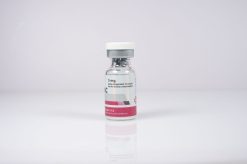-
×
 Thymosin Beta 4 (TB500) 2mg
1 × $63.00
Thymosin Beta 4 (TB500) 2mg
1 × $63.00
Pramipexole Overview
Composition
Pramipexole is a synthetic drug that acts as a dopamine agonist, primarily used in the treatment of Parkinson’s disease and restless leg syndrome (RLS). The product contains 2 mg of Pramipexole per tablet.
How It Works
Pramipexole works by stimulating dopamine receptors in the brain, mimicking the effects of dopamine, a neurotransmitter responsible for regulating movement, mood, and other functions. By activating dopamine receptors, Pramipexole can alleviate the symptoms of dopamine deficiency found in conditions like Parkinson’s disease and RLS. It improves motor control, reduces tremors, and helps manage muscle stiffness. Additionally, Pramipexole has been shown to have mood-enhancing properties and can help with certain forms of depression and fatigue.
Benefits for Users
- Parkinson’s Disease Management: Pramipexole helps reduce motor symptoms of Parkinson’s, such as tremors, stiffness, and bradykinesia (slowness of movement).
- Restless Leg Syndrome Relief: It is commonly used to treat RLS, helping to alleviate the uncomfortable urge to move the legs, particularly at night.
- Mood Enhancement: Pramipexole may improve mood and alleviate symptoms of depression in certain cases, as it has been shown to act on the brain’s reward pathways.
- Improved Sleep Quality: Due to its effects on dopamine, it can aid in improving sleep for those suffering from restless leg syndrome or dopamine imbalance.
- Increased Energy and Alertness: Pramipexole may help reduce fatigue and improve alertness, especially in individuals with Parkinson’s disease.
Importance in Treatment Protocols
Pramipexole is primarily used to manage symptoms of Parkinson’s disease and restless leg syndrome, but it may also be prescribed off-label for conditions like certain types of depression and fatigue. It plays a vital role in balancing dopamine levels in the brain, contributing to improved quality of life for individuals with these disorders.
Typical Dosage Guidelines
- Parkinson’s Disease
- Beginner:
- Dosage: 0.125-0.25 mg 3 times daily
- Duration: Adjusted based on tolerance and effectiveness
- Purpose: To initiate treatment and gradually increase dopamine activity.
- Intermediate:
- Dosage: 0.5-1 mg 3 times daily
- Duration: Adjust based on symptom control
- Purpose: To optimize motor control and symptom relief.
- Advanced:
- Dosage: 1-1.5 mg 3 times daily
- Duration: Long-term management
- Purpose: For maximum symptom control, if required.
- Beginner:
- Restless Leg Syndrome
- Beginner:
- Dosage: 0.125 mg 1-2 hours before bedtime
- Duration: Adjusted for effectiveness
- Purpose: To reduce symptoms of RLS, primarily at night.
- Intermediate:
- Dosage: 0.25-0.5 mg 1-2 hours before bedtime
- Duration: Tailored to individual need
- Purpose: For optimal relief of nighttime leg discomfort.
- Beginner:
Administration
Pramipexole is typically taken orally in tablet form, with or without food. For Parkinson’s disease, it is often divided into multiple doses throughout the day, while for RLS, it is typically taken once before bedtime. Dosages should be started low and gradually increased to avoid potential side effects.
Potential Side Effects
- Drowsiness and Sleepiness: One of the most common side effects, especially when starting or adjusting doses.
- Dizziness or Lightheadedness: May occur when standing up quickly, especially during the first few days of treatment.
- Nausea or Vomiting: Some users experience gastrointestinal discomfort.
- Hallucinations or Confusion: In rare cases, particularly at higher doses or in elderly individuals, users may experience visual or auditory hallucinations.
- Swelling in the Legs or Ankles: This can occur, particularly with higher doses or long-term use.
- Impulse Control Disorders: Some individuals may experience changes in behavior such as compulsive gambling, shopping, or sexual behaviors.
- Fatigue: Especially when adjusting to the medication or at higher doses.
Mitigating Side Effects
- Start with Low Doses: Begin with the lowest possible dose and gradually increase it to minimize side effects like drowsiness or dizziness.
- Take with Food: Taking Pramipexole with food can help reduce nausea or stomach upset.
- Monitor Mood and Behavior: Be aware of any sudden changes in behavior or mood, and consult with a healthcare provider if impulsive behaviors develop.
- Stay Hydrated and Avoid Sudden Movements: To reduce dizziness, it’s helpful to stay well-hydrated and avoid standing up too quickly.
- Consult a Healthcare Provider: For any persistent or concerning side effects, speak with a doctor to adjust dosage or switch medications if necessary.
Conclusion
Pramipexole is a powerful dopamine agonist used primarily for managing Parkinson’s disease and restless leg syndrome, but it can also have beneficial effects on mood and energy levels. By stimulating dopamine receptors, it helps alleviate symptoms such as tremors, stiffness, and sleep disturbances. While it offers significant benefits for those with dopamine-related disorders, it’s important to start with low doses and monitor for potential side effects, particularly in terms of mood changes or impulse control issues. Always follow a healthcare provider’s guidance for safe and effective use.
Related products
Sale!
BeligasCAN
Sale!
BeligasCAN
Sale!
Peptides











